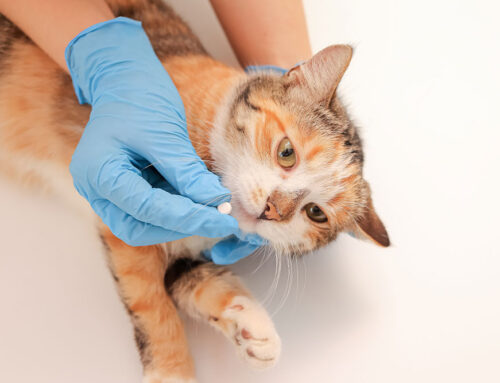If there is one thing pet owners dread dealing with, it’s fleas, ticks, and other creepy-crawly parasites. Not only are these pests a nuisance, but they also are uncomfortable for our pets, can spread disease, and can be a big pain to eliminate. Rather than dealing with a pet parasite problem, a better solution is to prevent one from occurring. Before we get into the details of parasite prevention, let’s review some common bugs that affect pets—and why they need to be avoided.
Fleas and pets
This tiny, flightless insect bothers dogs, cats, and other small mammals by jumping on their body and finding a nice, cozy home next to the skin. After a blood meal, courtesy of your pet, an adult female flea will lay her eggs—as many as 50 per female per day—right onto your pet’s fur. Many of these eggs will remain on your pet, while others may fall off into the environment where your pet hangs out. In about 2 to 14 days, the eggs will hatch, larvae will develop into pupae, and then eventually into adult fleas that continue the life cycle. Given how quickly fleas reproduce—both on and around your pet—getting rid of them can require multiple treatments for your pets and your home. And, since fleas feed off your pet’s blood, a large infestation can lead to anemia (i.e., low red blood cell count). Not to mention, dog and cat fleas often carry tapeworms that can be transmitted not only to your pet, but also other family members.
Ticks and pets
Unlike fleas, ticks don’t typically lay eggs or reproduce on your pet’s body, but if you live in an area rife with ticks, your pet may be bitten by multiple ticks at the same time. Like fleas, ticks feed off your pet’s blood, but they take more than a quick sip—ticks bury their mouthparts deep in the skin, and hang there while they drink. Most ticks will ingest approximately 200 times their body weight in blood at each meal. Eventually, the tick will detach itself, drop off your pet, and await another host for its next meal. While most pets—or people—don’t notice when a tick bite occurs, recognizing and removing ticks promptly is important, because they are capable of spreading infectious conditions like Lyme disease, Anaplasma spp, and Ehrlichia spp, among others. Although these tick-borne diseases are rarely transmitted between pets and their owners, people can acquire the same conditions, making tick avoidance beneficial for the entire family.
Lice and pets
Like fleas and ticks, lice feed off either your pet’s blood or skin debris, depending on the species. While lice that affect pets don’t typically carry harmful diseases or infect people, they can cause such significant discomfort that pets incessantly scratch, bite, or rub themselves, which can bother other family members as well as your furry friend. Not to mention—if one pet has lice, other household pets will likely be affected, too.
Mites and pets
Mites are tiny pests that, like most other ectoparasites, reside on your pet’s skin. Many mite species, most of which burrow under the skin causing irritation, hair loss, and a host of associated skin problems, can affect pets. Sarcoptes scabeii is one such mite that causes the condition commonly known as mange. Left untreated, mange can lead to significant skin problems and considerable discomfort, and is extremely contagious—to people, as well as pets. The demodex mite is another species that affects pets, usually dogs, and may require treatment, but fortunately is not contagious to people or other pets.
How can you protect your pet?

One of the most important things you can do as a pet owner is help your furry friend stay parasite-free. Fleas, ticks, and other ectoparasites affect pets worldwide, and throughout the year—not only in the spring and summer—especially here, in our mild climate. Thanks to advancements in veterinary medicine and pharmaceuticals, plenty of safe and effective options are available for your pet. From collars, to long-lasting chewable tablets, to topical liquids, you can find a parasite preventive for every pet and lifestyle. For whichever product you choose, ensure you do the following, before you administer the preventive to your pet:
- Check with your veterinarian — Discuss preventive options with our WesVet Animal Hospital veterinary team before starting your pet on a new medication, especially if your pet is young, old, nursing, or pregnant.
- Check the species — Ensure the product is labeled for your pet’s species (i.e., never give a product labeled for a dog to a cat).
- Check for approval — Check that the product is EPA-registered or FDA-approved.
- Check the weight — Ensure that the weight range listed on the label is appropriate for your pet.
At WesVet Animal Hospital, we are passionate about preventive care—and parasites are no exception. For questions regarding parasite prevention, or to learn more about this important facet of wellness care, contact us.







Leave A Comment